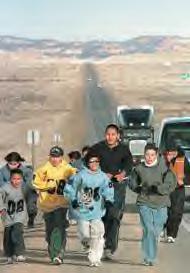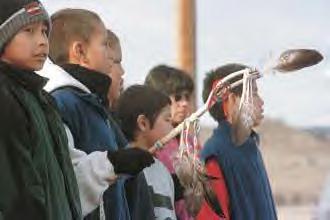 Dawn Spang grew up wanting out of here. You always see the drinking, the poverty, the people getting
old before their time, she said. She had to leave the reservation before she could see that this land is beautiful. Dawn Spang grew up wanting out of here. You always see the drinking, the poverty, the people getting
old before their time, she said. She had to leave the reservation before she could see that this land is beautiful.
She had to run 400
miles before she felt the spirit of her people.
"It's phenomenal,"
Spang said. "You think there's nothing here, and there's this whole spiritual side of it."
Spang was one of
38 runners from the Northern Cheyenne Reservation who ran in the second annual Fort Robinson Break Out Run - a
400-mile relay the first week of January. The runners trekked from Fort Robinson, Neb., to Busby. They carried
a sacred staff and ran a sacred course.
The run marks a
bloody chapter of Northern Cheyenne history. On Jan. 9, 1879, 164 Northern Cheyenne - mostly the sick, the old,
women and children - broke out of the barracks at Fort Robinson, where they were starving. They were the weaker,
slower half of the Northern Cheyenne, who by then had dwindled to about 300 after the U.S. soldiers drove them
from Montana to Oklahoma.
In 1878, under the
direction of chiefs Little Wolf and Dull Knife, the tribe embarked on a daring journey. They were going to walk
from Oklahoma, where their people were dying, to Montana, their ancestral home. Some of the tribe stayed behind
- today they are the Southern Cheyenne.
The group made it
as far as Nebraska and broke into two bands. Little Wolf would lead the healthy on to Montana, while Dull Knife
would seek help with their allies, the Lakota, for his band of the sick and weak.
Dull Knife never
made it. Troops caught up and marched them 28 miles to Fort Robinson, where they were imprisoned without food,
water or heat.
After five days,
the band broke out. Most were gunned down within minutes. A small group took shelter in a shallow creekside, where
troops later found them and shot them at point-blank range. Dull Knife and a handful of his family somehow made
it to South Dakota. They ate their moccasins to survive.
He lived to see
Montana, though. He died there four years after the massacre.
About seven years
ago, Phillip Whiteman Jr., son of a hereditary Northern Cheyenne chief, started organizing runs every January to
mark the event. The early runs didn't leave the reservation, but gathered crowds numbering into the hundreds.
Last year, he and
co-organizer Lynette Two Bulls, of the Oglala Sioux tribe in South Dakota, launched the current ultra-marathon,
retracing the steps the Northern Cheyenne ancestors never got to take.
Most people, Whiteman
said, don't know why their reservation is here, in the shadow of the Rosebud Mountains, where Deer Creek merges
with the Rosebud. They don't know what their people gave to live on this land and how the tribe almost died off
in the exodus to Montana.
"There's a
lot of people older than me that haven't even been to Fort Robinson," Whiteman said. "A lot of them have
given up. When you fall into that distress, you don't know where you came from or where you're going."
Last year's run,
in bitter temperatures and with little money, contained mostly young men, whom Whiteman called, "tall, slim,
lean machines." The group ran out of money, and ran all night at the end to save on hotel bills.
This year, the run
attracted more money and more "everyday people," Whiteman said. The Sacred Hoop Runners of South Dakota
also joined them.
 While only two women ran last year, 13 women and girls
took part this January. They ran in pairs, man and woman, boy and girl. Women, who are considered sacred in Northern
Cheyenne theology, do not carry the eagle feather staff, Whiteman said. The staff symbolizes sacrifice in battle,
he said, and the Northern Cheyenne believe women should be protected, not sacrificed as warriors. While only two women ran last year, 13 women and girls
took part this January. They ran in pairs, man and woman, boy and girl. Women, who are considered sacred in Northern
Cheyenne theology, do not carry the eagle feather staff, Whiteman said. The staff symbolizes sacrifice in battle,
he said, and the Northern Cheyenne believe women should be protected, not sacrificed as warriors.
"With the women
and children, it was more spiritual," Whiteman said. "It was more powerful, more real."
It's only natural
to bring in everyone when the Northern Cheyenne throw an event like the run, Two Bulls said.
"They're all
a part of the circle," she said. "You have your infants, the adults and the elderly, you can't separate
them."
Spang, 33, had run
half-marathons with her dad. A mother of two daughters and three sons, she said she wants her children to live
peacefully on the family's land on Muddy Creek and not get mired in the reservation's problems.
"I want them
to be able to live here and be happy," she said.
Special note: All are welcome to run next year.
For more information, call organizer Phillip Whiteman Jr. in Busby, 406-477-8720. |


